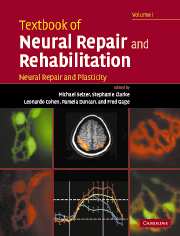Book contents
- Frontmatter
- Contents
- Contents (contents of Volume II)
- Preface
- Contributors (contributors of Volume I)
- Contributors (contributors of Volume II)
- Neural repair and rehabilitation: an introduction
- Section A Neural plasticity
- Section A1 Cellular and molecular mechanisms of neural plasticity
- Section A2 Functional plasticity in CNS system
- Section A3 Plasticity after injury to the CNS
- Section B1 Neural repair
- Section B2 Determinants of regeneration in the injured nervous system
- Section B3 Promotion of regeneration in the injured nervous system
- Section B4 Translational research: application to human neural injury
- 31 Alzheimer's disease, model systems and experimental therapeutics
- 32 Biomimetic design of neural prostheses
- 33 Brain–computer interfaces for communication and control
- 34 Status of neural repair clinical trials in brain diseases
- Index
34 - Status of neural repair clinical trials in brain diseases
from Section B4 - Translational research: application to human neural injury
Published online by Cambridge University Press: 05 March 2012
- Frontmatter
- Contents
- Contents (contents of Volume II)
- Preface
- Contributors (contributors of Volume I)
- Contributors (contributors of Volume II)
- Neural repair and rehabilitation: an introduction
- Section A Neural plasticity
- Section A1 Cellular and molecular mechanisms of neural plasticity
- Section A2 Functional plasticity in CNS system
- Section A3 Plasticity after injury to the CNS
- Section B1 Neural repair
- Section B2 Determinants of regeneration in the injured nervous system
- Section B3 Promotion of regeneration in the injured nervous system
- Section B4 Translational research: application to human neural injury
- 31 Alzheimer's disease, model systems and experimental therapeutics
- 32 Biomimetic design of neural prostheses
- 33 Brain–computer interfaces for communication and control
- 34 Status of neural repair clinical trials in brain diseases
- Index
Summary
Introduction
The interest in neuronal replacement therapies for human brain disorders dates back to the late 1970s when it was demonstrated that intrastriatal grafts of embryonic mesencephalic tissue, rich in dopamine (DA) neurons, induced functional recovery in rats with neurotoxin-induced lesions of the nigrostriatal dopaminergic system (for references see, e.g., Brundin et al., 1994). These observations provided the first evidence that neurons implanted into the adult brain could reverse behavioral deficits in an animal model of a human neurological disorder, Parkinson's disease (PD). Based on a bulk of experimental data in rodents and non-human primates (Annett, 1994; Brundin et al., 1994), the first clinical trials with neural transplantation in PD were initiated in 1987. Successful studies in animal models of Huntington's disease (HD) (for references see, e.g., Dunnett et al., 2000) lead to the first attempts with embryonic striatal grafts implanted into the striatum of HD patients in the 1990s. In addition, neural transplantation has been applied, with varying degree of scientific foundation, also in patients with other disorders such as stroke and epilepsy. Although the clinical studies with primary embryonic tissue seem to provide proof-of-principle for the cell replacement strategy, at least in PD (see Volume II, Chapter 6), it is obvious that other sources of cells are needed if cell-based approaches should become clinically competitive.
Keywords
- Type
- Chapter
- Information
- Textbook of Neural Repair and Rehabilitation , pp. 615 - 632Publisher: Cambridge University PressPrint publication year: 2006



